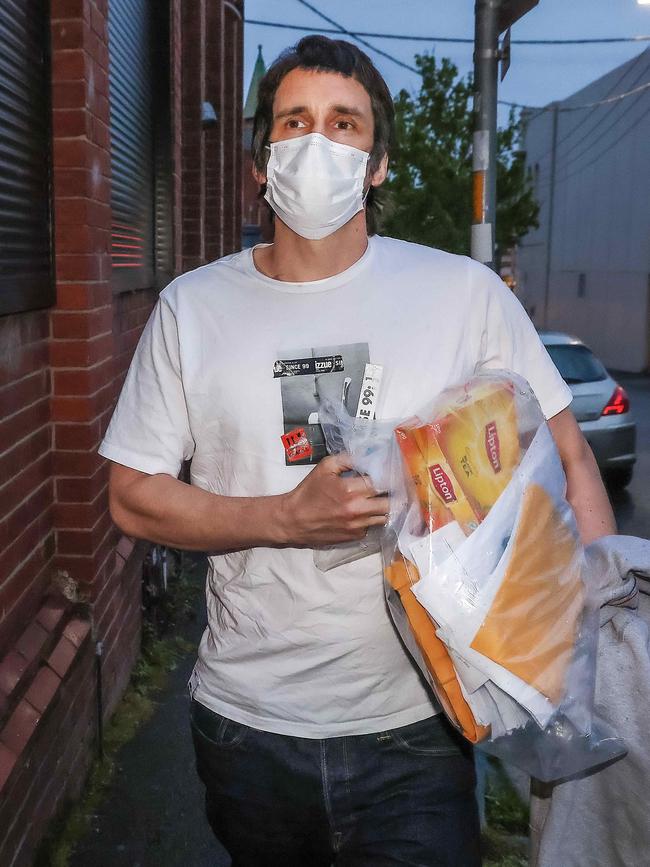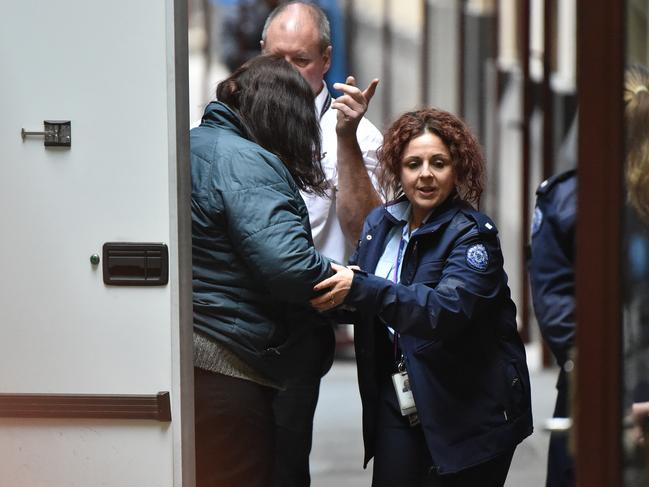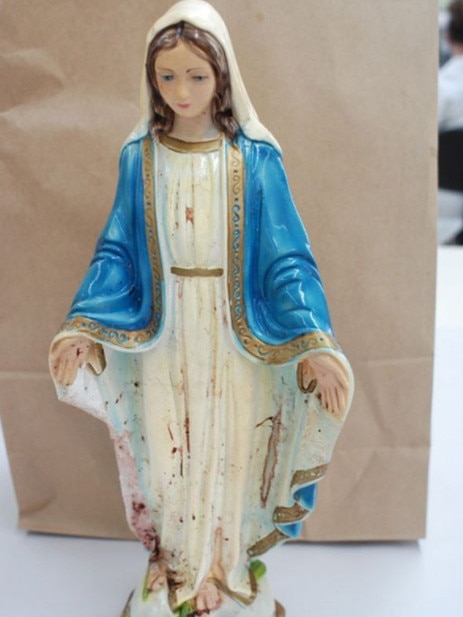Andrew Rule: How Dermot Dann became Melbourne’s ‘preeminent’ criminal barrister
Dermot Dann’s path to becoming the “preeminent” criminal barrister, with a client list ranging from Jordan De Goey to the accused High Country killer, started in 2005 when an old man’s body was found in an East Kew home.

Police & Courts
Don't miss out on the headlines from Police & Courts. Followed categories will be added to My News.
A sports-loving Hawthorn fan, bored solicitor by trade, once registered the name Demolition Dermie Pty Ltd as a jokey tribute to Hawk hero Dermott Brereton.
It’s a long while since Brereton demolished a pack, but a different incarnation of Demolition Dermie is going strong in another tough arena.
His name is Dermot Dann KC. The one-time welterweight wingman is now a heavyweight title contender among Australian criminal barristers. Not that he’d say it himself.
Demolition Dermie handles court as well as he handled the ball with Melbourne Under 19s before a crackerjack 200-game career with Old Xavs.
At the bar table, the former amateur footballer is all pro.
According to someone who watched Dann doing his best work, he’s a complete craftsman — “not a glory hunter like a lot of barristers.”
He’s not one to grandstand for the jury or to crack too many cosy learned-friend jokes with the judge. In court, he’s all business, methodically unravelling a case so others see facts as clearly as he does.
Dann KC is a quiet achiever who does his best work with a scalpel, not a bulldozer or a bullhorn. It says something that, until lately, many of his clients have been better-known than he was.
His client list includes Wonnangatta double murder accused Greg Lynn; bumbling bikie hitman Josh Rider (the Eastlink freeway murder of fruiterer Paul Virgona); Porsche-driving sociopath Richard Pusey; innocent Collingwood star Jordan De Goey; former St Kilda player and alleged drug trafficker Sam Fisher; Tigerland tattoo expert Jake King; soccer “bucket man” Alex Agelopoulos, who injured Melbourne City’s goalkeeper by throwing a bucket at his face in a pitch invasion.
Then there’s Vincenzo Crupi, charged with the 2016 murder of gangland lawyer Joe Acquaro. Sex killer Michael Cardamone, who murdered Karen Chetcuti in 2016, also retained Dann. So did Ultra Tune boss and racing bigwig Sean Buckley, who faces stalking charges.
When prominent Sydney dermatologist Dr Liang Joo Leow had stealth-rape allegations made against him, he called Dann and was found not guilty. Likewise former Cricket Australia executive Timothy Whittaker, beating sex charges that could have put him in prison.
It’s not all rape and murder. Dann’s latest brief is defending Zuo Chen, accused last month over a $228 million money-laundering syndicate.
Dann cannot take everything he’s offered but chooses from a wide range. He races between adjournments, say courthouse insiders who watch him juggle cases with something between admiration and exasperation.
After 35 years of honing his craft Dann the man is an overnight success. He has edged into the limelight that was once the favourite place of his first mentor “Mr Frank” Galbally, legendary advocate from the venerable Galbally & O’Bryan firm, cradle of so many ace defenders.
But if there’s one case underpinning Dann’s recent nomination as a “preeminent” criminal barrister (slotting him above old lions like Philip Dunn KC and Robert Richter KC) it was his painstaking work for a one-time McDonalds worker forced to stand trial four times over the killing of a Kew pensioner.


Her name is Katia Pyliotis. Without Dann’s forensic care and sustained concentration, she would still be serving a 19-year sentence for a crime she likely did not commit because it’s more likely someone else did.
The charging of Pyliotis 11 years after 69-year-old Eliah Abdelmessih was bludgeoned to death points to the risks of DNA evidence when police, prosecutors and courts blindly embrace swabs, test tubes and fallible laboratory workers over logic, common sense and confessions.
The ordeal of Katia Pyliotis also shows how cynical police witnesses can doctor evidence to bluff judges and juries into accepting hunches as fact.
To understand Dann’s service to Katia Pyliotis and to justice we need to go back to September 2005, when Abdelmessih’s body was found in his East Kew house.
He had been bashed with blunt objects some time on Sunday, September 18. There was blood, some of it on a can of tinned mangoes. Likewise a ceramic statuette of the Virgin Mary, painted cream and blue.
It took detectives 10 days to join the dots and go to the nearby Yooralla supported accommodation unit to interview a person of great interest, Susan Louise Reddie.
Witnesses had told police Reddie knew the murdered man. He often talked to her at her regular spot outside the local supermarket, where she’d sip cask wine and beg for change.
Significantly, Reddie had been seen getting into Abdelimessih’s car in the months before his death. Most homicide victims are killed by someone they know, often intimately.
On Wednesday, September 28, detectives Warren Ryan and Wayne Newman asked Reddie about her links with the dead man, whose house was a 20-minute walk away from her Yooralla unit.
At 47, Susan Reddie showed signs of a hard and tragic life. As a reporter later found, she came from a farming family in western Victoria but had been badly disturbed when her father was accidentally killed when she was 14.

By her 20s, she had become an erratic, alcoholic drug user with signs of the acquired brain injury that eventually led her to live at Yooralla.
It was this damaged woman that the lonely and strange older man, an Egyptian-born widower, paid for sex at his house. It’s clear why detectives had to interview her. Still unclear is why they didn’t act on it.
Reddie, known locally as “Crazy Sue,” cooperated willingly and admitted assaulting Abdelmessih but said she couldn’t remember much because she’d been “drunk as a dog” that weekend.
Investigators are trained to keep open minds and not leap to conclusions but it was clear Susan Reddie was the only obvious suspect in a sad and sordid episode.
The police interviewed her informally at the hostel then formally at St Kilda Rd. That evening she confided to her carer, Ross Bracken, that she had attacked Abdelmessih because he had made her angry with an offensive sexual demand.
Bracken immediately called the police about the confession but they did not interview him for another six days. Astonishingly, they never re-interviewed Susan Reddie at all.
Det. Ryan would later swear that Reddie told him she’d confessed only because she thought that’s what they wanted her to do. His claim of Reddie recanting her confession was enough to jail Katia Pyliotis — until, that is, Dermot Dann demolished Ryan’s credibility with unflinching cross-examination in a 2020 hearing that killed the prosecution’s attempt to launch a fifth trial against Katia Pyliotis after her release on appeal.
Dann’s performance led Justice Elizabeth Hollingworth to stay proceedings permanently, effectively freeing Pyliotis forever after three failed trials and the fourth in which she was convicted before winning the appeal.

Prudent police are wary of false confessions for good reason, withholding details of a crime that only the real culprit could know. In this case, such details should have included the “blunt objects” with the body — the can of mangoes and the religious statuette used to hit the victim.
Significantly, Reddie said she’d hit Abdelmessih and described the statuette’s cream and blue colour.
The detectives were scrupulously fair to Reddie, ensuring she had a support person with her and carefully explaining her rights.
It was an example of not pressuring a vulnerable person. But the fact was in 2005 that Reddie was the only viable suspect, given she had confessed to an assault with an object she’d described. Quite enough, you’d think, to support a “reasonable doubt” defence for anyone else charged later.
The homicide squad’s failure to charge Reddie (and her subsequent death in 2012) would lead to Katia Pyliotis being charged with the murder a decade later.
The police case was that there was strong DNA evidence implicating Pyliotis, whereas Reddie’s DNA was apparently absent from the victim’s house despite her admitted visits there.
In 2005, Pyliotis worked at the Kew McDonalds store where Abdelmessih ate several times a week. People who followed the case closely say she came across as a kindly young woman who took pity on a lonely old man.
As some kind people do with lonely older people, she visited Abdelmessih semi-regularly because she felt sorry for him.
Pyliotis was never a suspect in 2005 and was unknown to police then. But the unidentified female DNA found at the murder house puzzled detectives enough that they second guessed the obvious explanation that “Crazy Sue” — erratic, drunk, potentially violent — had lashed out at the man exploiting her for sex.
As 2005 turned into 2006, the case went cold. Meanwhile, the unidentified DNA samples from the house went to the national database.
Which is why, in 2016, when a volunteer charity worker in Adelaide was booked driving an unregistered car and asked to do a routine DNA swab, the database got a “hit”: the Adelaide driver’s DNA matched unidentified DNA from Abdelmessih’s house in 2005.
The driver was Katia Pyliotis, whose world caved in. Confused and distraught, she came across poorly in police interviews after Victorian detectives arrived to charge her for the 11-year-old cold case.
Her story, then and now, was that she had gone to Abdelmessih’s house that Sunday to see him as she sometimes did — but this time she found his body. Horrified and scared she would be blamed, she said, she fled, leaving multiple DNA traces at the scene.
After three failed trials, Pyliotis was convicted and jailed in the fourth when Justice Paul Coghlan made what Dann would expose as a “negative and scathing assessment” about her to the jury.
Dann represented Pyliotis in the appeal court then demolished the police case in front of Justice Hollingworth when prosecutors attempted to try Pyliotis a fifth time.
Det. Ryan had sworn that Reddie had told him she’d made up her confession but he claimed his 2005 diary could not be found to confirm it.
Unlike other lawyers, Dann doggedly insisted on stringent searches of police archives until the missing diary was found.
To Ryan’s embarrassment, and the judge’s justifiable anger, the police diary contained the detective’s notes that Susan Reddie admitted her guilt, with no reference to the later denial that Ryan swore to in the trial that had jailed Pyliotis.
It was enough for Justice Hollingworth to suggest that Ryan told lies and that his fellow detective, Wayne Newman (she called him “the smirking superintendent”) was unreliable.
Dann’s masterful performance had saved Katia Pyliotis from a murder sentence, demolishing tough witnesses without once raising his voice.
None of which explains why Susan Reddie’s DNA was not found at the crime scene. In a case full of human error, or worse, that mystery might represent more of the same.




